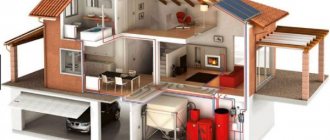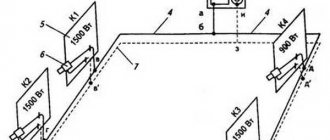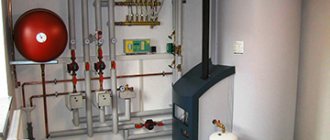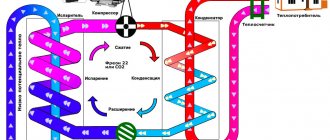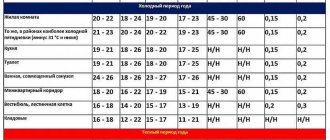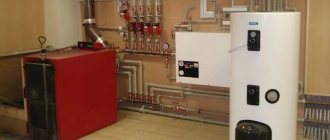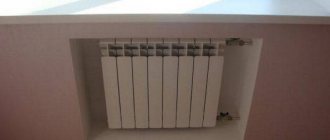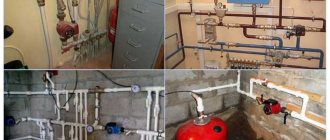Design and thermal calculation of a heating system is a mandatory stage when arranging home heating. The main task of computational activities is to determine the optimal parameters of the boiler and radiator system.
Agree, at first glance it may seem that only an engineer can carry out thermal engineering calculations. However, not everything is so complicated. Knowing the algorithm of actions, you will be able to independently perform the necessary calculations.
The article describes in detail the calculation procedure and provides all the necessary formulas. For a better understanding, we have prepared an example of a thermal calculation for a private home.
Standards for room temperature conditions
Before carrying out any calculations of system parameters, it is necessary, at a minimum, to know the order of the expected results, and also to have standardized characteristics of some tabular values that need to be substituted into formulas or be guided by them.
By calculating parameters with such constants, you can be confident in the reliability of the desired dynamic or constant parameter of the system.
For premises of various purposes, there are reference standards for temperature conditions in residential and non-residential premises. These standards are enshrined in the so-called GOSTs
For a heating system, one of these global parameters is the room temperature, which must be constant regardless of the season and environmental conditions.
According to the regulations of sanitary standards and rules, there are differences in temperature relative to the summer and winter periods of the year. The air conditioning system is responsible for the temperature regime of the room in the summer season; the principle of its calculation is described in detail in this article.
But the room temperature in winter is provided by the heating system. Therefore, we are interested in temperature ranges and their deviation tolerances for the winter season.
Most regulatory documents stipulate the following temperature ranges that allow a person to stay comfortably in the room.
For non-residential office premises with an area of up to 100 m2:
- 22-24°C - optimal air temperature;
- 1°C is an acceptable fluctuation.
For office-type premises with an area of more than 100 m2, the temperature is 21-23°C. For non-residential industrial premises, temperature ranges vary greatly depending on the purpose of the room and established labor protection standards.
Each person has their own comfortable room temperature. Some people like it to be very warm in the room, others feel comfortable when the room is cool - it’s all quite individual
As for residential premises: apartments, private houses, estates, etc., there are certain temperature ranges that can be adjusted depending on the wishes of the residents.
And yet, for specific premises of an apartment and house we have:
- 20-22°С - living room, including children's room, tolerance ±2°С -
- 19-21°С - kitchen, toilet, tolerance ±2°С;
- 24-26°С – bathroom, shower, swimming pool, tolerance ±1°С;
- 16-18°C - corridors, hallways, staircases, storerooms, tolerance +3°C
It is important to note that there are several more basic parameters that affect the temperature in the room and which you need to focus on when calculating the heating system: humidity (40-60%), concentration of oxygen and carbon dioxide in the air (250:1), air movement speed mass (0.13-0.25 m/s), etc.
Calculation of heat loss in the house
According to the second law of thermodynamics (school physics), there is no spontaneous transfer of energy from less heated to more heated mini- or macro-objects. A special case of this law is the “striving” to create temperature equilibrium between two thermodynamic systems.
For example, the first system is an environment with a temperature of -20°C, the second system is a building with an internal temperature of +20°C. According to the above law, these two systems will strive to balance through the exchange of energy. This will happen with the help of heat losses from the second system and cooling in the first.
We can definitely say that the ambient temperature depends on the latitude at which the private house is located. And the temperature difference affects the amount of heat leakage from the building (+)
Heat loss refers to the involuntary release of heat (energy) from some object (house, apartment). For an ordinary apartment, this process is not so “noticeable” in comparison with a private house, since the apartment is located inside the building and “adjacent” to other apartments.
In a private house, heat escapes to one degree or another through the external walls, floor, roof, windows and doors.
Knowing the amount of heat loss for the most unfavorable weather conditions and the characteristics of these conditions, it is possible to calculate the power of the heating system with high accuracy.
So, the volume of heat leakage from the building is calculated using the following formula:
Q=Qfloor+Qwall+Qwindow+Qroof+Qdoor+…+Qi , where
Qi is the volume of heat loss from a homogeneous type of building envelope.
Each component of the formula is calculated using the formula:
Q=S*∆T/R , where
- Q – heat leakage, V;
- S – area of a specific type of structure, sq. m;
- ∆T – difference in ambient and indoor air temperatures, °C;
- R – thermal resistance of a certain type of structure, m2*°C/W.
It is recommended to take the very value of thermal resistance for real existing materials from auxiliary tables.
Additionally, the thermal resistance can be obtained using the following relationship:
R=d/k , where
- R – thermal resistance, (m2*K)/W;
- k – coefficient of thermal conductivity of the material, W/(m2*K);
- d – thickness of this material, m.
In old houses with damp roofing structures, heat leaks occur through the upper part of the building, namely through the roof and attic. Taking measures to insulate the ceiling or insulate the attic roof solves this problem.
If you insulate the attic space and roof, the overall heat loss from the house can be significantly reduced
There are several other types of heat loss in the house through cracks in structures, ventilation systems, kitchen hoods, and opening windows and doors. But it makes no sense to take into account their volume, since they constitute no more than 5% of the total number of main heat leaks.
Increased heat transfer efficiency
When the radiator heats the internal air of the room, intense heating of the external wall in the area behind the radiator also occurs. This leads to additional unjustified heat losses.
To increase the efficiency of heat transfer from the radiator, it is proposed to fence off the heating device from the outer wall with a heat-reflecting screen.
The market offers many modern insulating materials with a heat-reflecting foil surface. The foil protects the warm air heated by the battery from contact with the cold wall and directs it inside the room.
For proper operation, the boundaries of the installed reflector must exceed the dimensions of the radiator and protrude 2-3 cm on each side. The gap between the heating device and the thermal protection surface should be left 3-5 cm.
To make a heat-reflecting screen, we can recommend isospan, penofol, alufom. A rectangle of the required dimensions is cut out of the purchased roll and fixed on the wall at the location where the radiator is installed.
It is best to fix the screen that reflects the heat of the heating device on the wall with silicone glue or liquid nails
It is recommended to separate the insulation sheet from the external wall with a small air gap, for example, using a thin plastic grid.
If the reflector is joined from several parts of insulating material, the joints on the foil side must be sealed with metallized adhesive tape.
Determination of boiler power
To maintain the temperature difference between the environment and the temperature inside the house, an autonomous heating system is required, which maintains the desired temperature in each room of a private house.
The heating system is based on different types of boilers: liquid or solid fuel, electric or gas.
A boiler is the central unit of a heating system that generates heat. The main characteristic of a boiler is its power, namely the rate of conversion of the amount of heat per unit of time.
After calculating the heating load, we obtain the required rated power of the boiler.
For an ordinary multi-room apartment, the boiler power is calculated through the area and specific power:
Rkotla=(Spremises*Mining)/10 , where
- Spremises - the total area of the heated room;
- Rudelnaya - specific power relative to climatic conditions.
But this formula does not take into account heat losses, which are sufficient in a private house.
There is another ratio that takes this parameter into account:
Rboiler=(Qloss*S)/100 , where
- Rkotla - boiler power;
- Qloss —heat loss;
- S - heated area.
The design power of the boiler needs to be increased. The reserve is necessary if you plan to use the boiler to heat water for the bathroom and kitchen.
In most heating systems of private houses, it is recommended to use an expansion tank in which the coolant supply will be stored. Every private home needs hot water supply
In order to provide for the boiler power reserve, the safety factor K must be added to the last formula:
Rboiler=(Qloss*S*K)/100 , where
K - will be equal to 1.25, that is, the design power of the boiler will be increased by 25%.
Thus, the boiler power makes it possible to maintain the standard air temperature in the rooms of the building, as well as to have an initial and additional volume of hot water in the house.
VALTEC CO 3.8. Heating system design software
VALTEC CO is a calculation and graphic program for designing radiator and underfloor heating systems using VALTEC equipment, developed by SANKOM Sp. z oo based on the latest version of the Audytor CO program – 3.8. The product allows you to design and regulate heating systems, and perform a full range of hydraulic and thermal calculations. The program is certified for compliance with the current construction standards of the Russian Federation and the requirements of the Voluntary Certification System of NP "ABOK" (
).
Features of the selection of radiators
Standard components for providing heat in a room are radiators, panels, underfloor heating systems, convectors, etc. The most common parts of a heating system are radiators.
The thermal radiator is a special hollow modular-type structure made of an alloy with high heat dissipation. It is made of steel, aluminum, cast iron, ceramics and other alloys. The principle of operation of a heating radiator is reduced to the radiation of energy from the coolant into the space of the room through the “petals”.
An aluminum and bimetallic heating radiator replaced massive cast-iron batteries. Simplicity of production, high heat transfer, successful design and design have made this product a popular and widespread instrument for radiating heat indoors
There are several methods for calculating heating radiators in a room. The list of methods below is sorted in order of increasing calculation accuracy.
Calculation options:
- By area . N=(S*100)/C, where N is the number of sections, S is the area of the room (m2), C is the heat output of one section of the radiator (W, taken from the data sheet or certificate for the product), 100 W is the amount of heat flow, which is necessary to heat 1 m2 (empirical value). The question arises: how to take into account the height of the ceiling of the room?
- By volume . N=(S*H*41)/C, where N, S, C are similar. H is the height of the room, 41 W is the amount of heat flow that is necessary to heat 1 m3 (empirical value).
- By odds . N=(100*S*k1*k2*k3*k4*k5*k6*k7)/C, where N, S, C and 100 are the same. k1 - taking into account the number of chambers in a double-glazed window of a room, k2 - thermal insulation of walls, k3 - ratio of window area to room area, k4 - average sub-zero temperature in the coldest week of winter, k5 - number of external walls of a room (which “extend” to the street), k6 - type of room above, k7 - ceiling height.
This is the most accurate option for calculating the number of sections. Naturally, fractional calculation results are always rounded to the next integer.
Video description
A specialist talks about the features of selecting a boiler and the dependence of its power on various characteristics of the house in the video:
Algorithm for calculating the amount of heat taking into account heat loss
Calculating the power of the heating system according to SNiP is the most accurate calculation method. It allows you to select effective equipment for heating rooms. Thermal power is calculated in the following sequence:
- The area of the ceiling, floor, all external walls, window structures in each room is measured.
- Heat loss through each fence of the house that is in contact with the street is calculated.
- The amount of heat consumed to heat the air coming from the ventilation system is determined.
- All previously obtained thermal energy values are added together.
Important! If the calculation of thermal loads is performed for a two-story house, then the calculations do not take into account interfloor ceilings, because they are not in contact with the environment.
Heat loss through the external building structures of a building is the amount of heat that “evaporates” to the street. In this case, the value for each material will be different, because they differ in thermal conductivity and thickness.
Heat loss through the external structures of a residential building Source twimg.com
On a note! When calculating the area of external walls, the quadrature of window openings is not taken into account. After all, more heat is always lost through translucent structures. Therefore, a separate calculation is performed for them.
When the width of the rooms is measured, then half the thickness of the interior partitions is added to the value. You also need to remember about the outer corner. Its size must be taken into account. When measuring, the total area of each building envelope of the house is considered. After all, heat loss occurs through its entire surface.
Hydraulic calculation of water supply
Of course, the “picture” of calculating heat for heating cannot be complete without calculating such characteristics as the volume and speed of the coolant. In most cases, the coolant is ordinary water in a liquid or gaseous aggregate state.
It is recommended to calculate the actual volume of coolant by summing all cavities in the heating system. When using a single-circuit boiler, this is the best option. When using double-circuit boilers in a heating system, it is necessary to take into account the consumption of hot water for hygienic and other domestic purposes
Calculation of the volume of water heated by a double-circuit boiler to provide residents with hot water and heat the coolant is made by summing the internal volume of the heating circuit and the actual needs of users for heated water.
The volume of hot water in the heating system is calculated by the formula:
W=k*P , where
- W is the volume of the coolant;
- P - heating boiler power;
- k - power factor (number of liters per unit of power, equal to 13.5, range - 10-15 liters).
As a result, the final formula looks like this:
W = 13.5*P
Coolant velocity is the final dynamic assessment of the heating system, which characterizes the speed of fluid circulation in the system.
This value helps to evaluate the type and diameter of the pipeline:
V=(0.86*P*μ)/∆T , where
- P - boiler power;
- μ - boiler efficiency;
- ∆T is the temperature difference between the supply water and the return water.
Using the above methods of hydraulic calculation, it will be possible to obtain real parameters that are the “foundation” of the future heating system.
Briefly about the main thing
The amount of heat required is always calculated when heating is created. After all, this is the only way to create an effective heating system for your home. Using this parameter, the rate of transfer of thermal energy from heating equipment and its consumption by a specific object is determined. The value of this characteristic depends on the volume of the house, the climatic zone of its location, the thermal conductivity of materials, the size of radiators, internal and external temperatures.
The required thermal energy can be calculated using a simplified or exact method. Methods based on aggregated data involve calculation by area or volume. For a more accurate calculation, the total heat loss of the object through all external building structures is determined. Additionally, the heat consumed for ventilation is taken into account.
Example of thermal calculation
As an example of a thermal calculation, we have an ordinary 1-story house with four living rooms, a kitchen, a bathroom, a “winter garden” and utility rooms.
The foundation is made of a monolithic reinforced concrete slab (20 cm), the external walls are concrete (25 cm) with plaster, the roof is made of wooden beams, the roof is metal tiles and mineral wool (10 cm)
Let us designate the initial parameters of the house necessary for the calculations.
Building dimensions:
- floor height - 3 m;
- small window on the front and rear of the building 1470*1420 mm;
- large facade window 2080*1420 mm;
- entrance doors 2000*900 mm;
- rear doors (exit to the terrace) 2000*1400 (700 + 700) mm.
The total width of the building is 9.5 m2, length 16 m2. Only living rooms (4 units), a bathroom and a kitchen will be heated.
To accurately calculate heat loss on the walls, you need to subtract the area of all windows and doors from the area of the external walls - this is a completely different type of material with its own thermal resistance
We start by calculating the areas of homogeneous materials:
- floor area - 152 m2;
- roof area - 180 m2, taking into account the attic height of 1.3 m and the purlin width - 4 m;
- window area - 3*1.47*1.42+2.08*1.42=9.22 m2;
- door area - 2*0.9+2*2*1.4=7.4 m2.
The area of the external walls will be 51*3-9.22-7.4=136.38 m2.
Let's move on to calculating heat loss for each material:
- Qfloor=S*∆T*k/d=152*20*0.2/1.7=357.65 W;
- Qroof=180*40*0.1/0.05=14400 W;
- Qwindow=9.22*40*0.36/0.5=265.54 W;
- Qdoors=7.4*40*0.15/0.75=59.2 W;
And also Qwall is equivalent to 136.38*40*0.25/0.3=4546. The sum of all heat losses will be 19628.4 W.
As a result, we calculate the boiler power: Rboiler = Qloss * Room heating * K / 100 = 19628.4 * (10.4 + 10.4 + 13.5 + 27.9 + 14.1 + 7.4) * 1.25/100 = 19628.4 * 83.7 * 1.25/100 = 20536.2 = 21 kW.
We will calculate the number of radiator sections for one of the rooms. For all others, the calculations are similar. For example, a corner room (on the left, lower corner of the diagram) has an area of 10.4 m2.
This means N=(100*k1*k2*k3*k4*k5*k6*k7)/C=(100*10.4*1.0*1.0*0.9*1.3*1.2*1.0*1.05)/180=8.5176=9.
This room requires 9 sections of heating radiator with a heat output of 180 W.
Let's move on to calculating the amount of coolant in the system - W=13.5*P=13.5*21=283.5 l. This means that the coolant speed will be: V=(0.86*P*μ)/∆T=(0.86*21000*0.9)/20=812.7 l.
As a result, a complete turnover of the entire volume of coolant in the system will be equivalent to 2.87 times per hour.
A selection of articles on thermal calculations will help you determine the exact parameters of the heating system elements:
- Calculation of the heating system of a private house: rules and calculation examples
- Thermal engineering calculation of a building: specifics and formulas for performing calculations + practical examples
Example No. 2
It is necessary to determine the brand of an open wall convector with a casing KN-20k “Universal-20”, which is installed on a single-pipe flow-through riser. There is no tap near the installed device.
Determines the average water temperature in the convector:
tcp = (105 - 2) - 0.5x1410x1.04x1.02x3.6 / (4.187x300) = 100.9 °C.
In Universal-20 convectors, the heat flux density is 357 W/m2. Available data: µtcp=100.9-18=82.9°C, Gnp=300kg/h. Using the formula qpr =qnom(µ tav /70)1+n (Gpr /360)p we recalculate the data:
qnp = 357(82.9 / 70)1+0.3(300 / 360)0.07 = 439 W/m2.
We determine the level of heat transfer of horizontal (1g-=0.8 m) and vertical (lw=2.7 m) pipes (taking into account Dy20) using the formula Qtr = qinxlw + qgxlg. We get:
Qtr = 93x2.7 + 115x0.8 = 343 W.
Using the formula Ap = Qnp/qnp and Qпp = Qп - µ ТрхQтр, we determine the estimated area of the convector:
Ar = (1410 - 0.9x343) / 439 = 2.51 m2.
That is, the “Universal-20” convector, the casing length of which is 0.845 m, was accepted for installation (model KN 230-0.918, the area of which is 2.57 m2).

